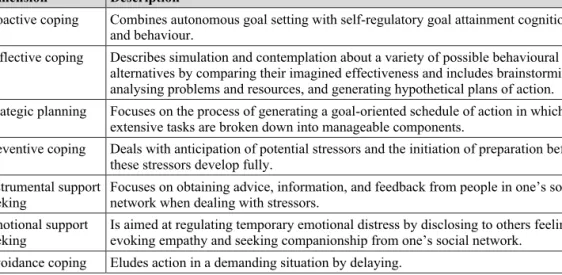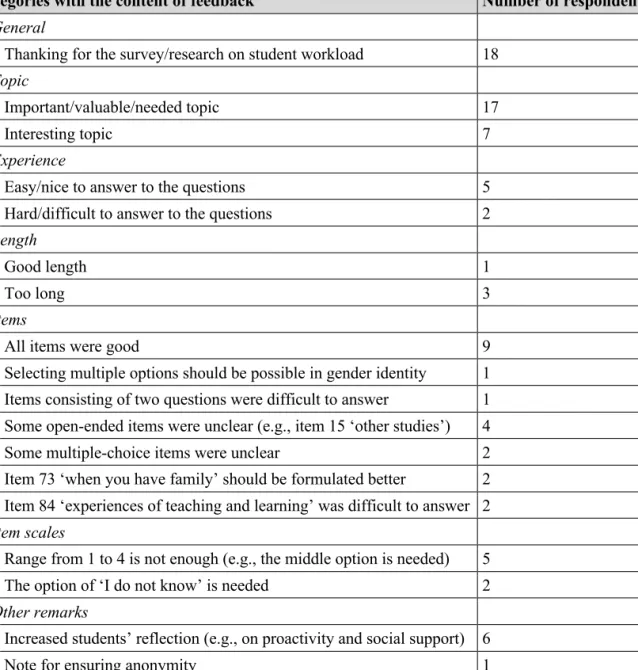Music students' perceived workload, livelihood and stress in higher education in Finland and the UK. This chapter outlines research into music students' perceived workload, stress and coping in higher education.
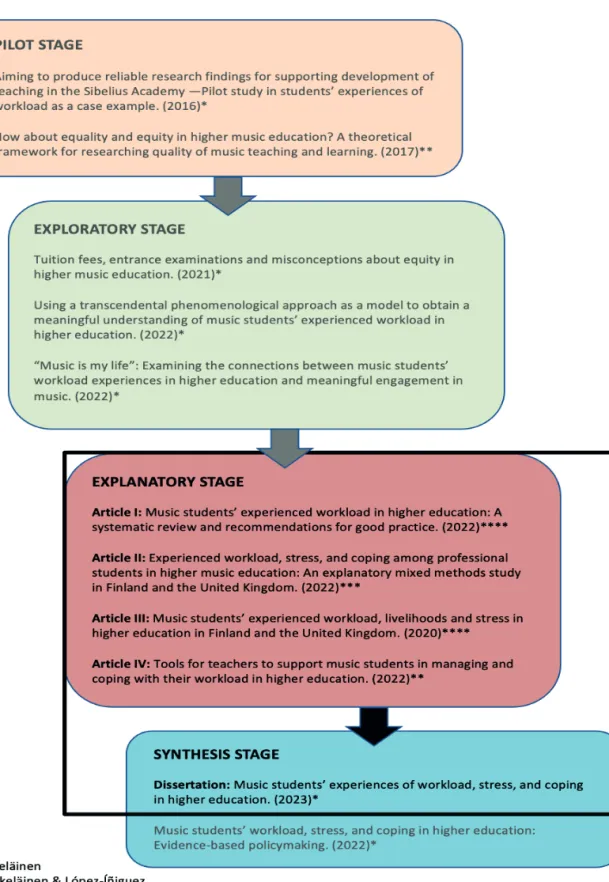
Music students’ experienced workload and their ability to manage it The first theme drawn from the systematic literature review was music
The interest is in all aspects of the positive, negative or neutral experiences of students' workload in their studies. Previous research shows that there are specific stressors that affect music students' studies, such as performance anxiety (Matei & Ginsborg, 2017), perfectionism (Bernhard, 2007a), stage fright (Nogaj, 2017), critical incidents (López -Íñiguez & Burnard, 2022), and career concerns as musicians (López- Íñiguez & Bennett, 2021).
Music students’ experienced workload related to interactions between teachers and students
Research in instrumental music teaching and learning at elementary levels has shown that teachers' beliefs and practices have a major impact (both positive and negative) on students' learning strategies and lived experiences, teaching and learning beliefs, studying autonomy and ' a sense of involvement in the classroom (López-Íñiguez & Pozo, 2014a, 2014b, 2016). Thus, one of the goals of learner-centered pedagogies linked to music students' handling of study.
Music students’ experienced workload related to social and environmental factors involved in studying music in higher education
The view of music students' perceived workload associated with educational arrangements and inequalities may be a way to ease the burden placed solely on students' shoulders. It is also crucial to address concerns about student workload due to higher music education practices and policies that still largely follow the nineteenth-century traditions of music conservatories (Bull, 2019).
Research questions
Can the perceived stress of music students be predicted by their perceived workload and proactive coping styles? Are there relationships between perceived major (or main study) workload and livelihoods (including socio-demographic characteristics, working while studying, funding and loans) of music students and perceived stress in higher education in Finland and the United Kingdom.
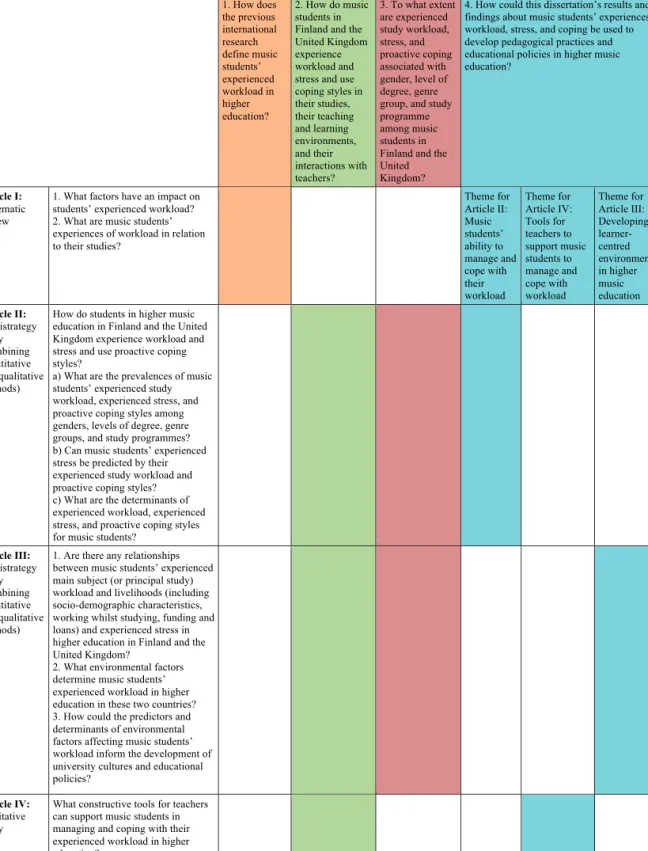
Research design and methodology
In accordance with practical time constraints (researcher's full-time work in addition to doctoral studies) and scope of study. Let us recall the researcher's own experiences of playing the piano as a hobby and working in university administration to become more aware of the researcher's own biases.
Research methods
In the studies reported in this dissertation (Articles II and III), Cronbach's alpha coefficient was 0.63. The Proactive Coping Inventory scales have high internal consistency—reported Cronbach's alpha coefficients for the Canadian student sample ranged from 0.71 to 0.85 for all seven scales—and good item-total correlations and acceptable bias as an indicator of symmetry around the mean (Greenglass et al., 1999).
Research ethics
The translated documents were pilot tested with Finnish and English-speaking music students and higher music education teachers to validate the items. The final documents were refined by their feedback - for example, the wording of three items in the PCI-A was changed after obtaining written permission from Professor Greenglass (compare items 38, 39 and 43 in Appendix 7 with the original wording in Greenglass et al. , 2008).
Participants
An invitation to participate in the research was sent through student email lists, potentially reaching over 7,000 music students. Thus, the study was expanded to include them in the data collection phase—including the survey and interviews.
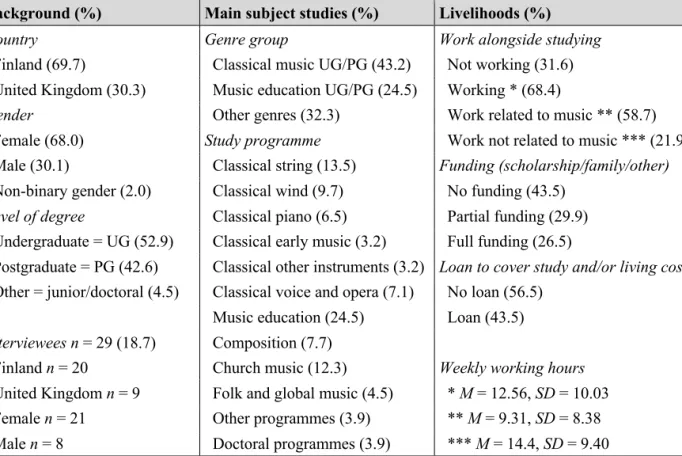
Analysis procedures
Music students' ability to cope with their workload (including extracts relating to 'the student' in four of the categories on the left). Tools for teachers to support music students to manage and cope with workload (including extracts relating to 'the teacher'. in four of the categories on the left). The development of learner-centred environments in higher music education (including extracts relating to 'the . environment' in four of the categories on the left).
In the sixth chapter, the results and findings of all the articles will be combined to discuss the overarching research question: What are music students' experiences of workload, stress and coping in higher education?
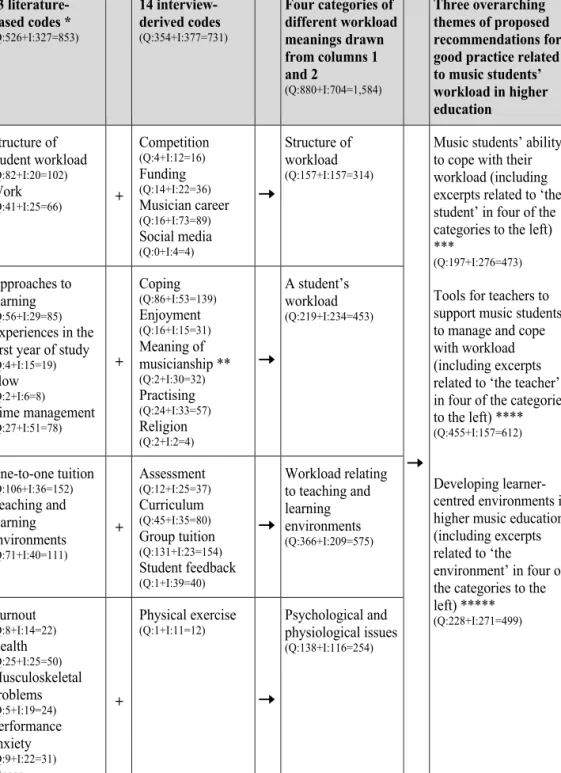
Article I: Music students’ experienced workload in higher education
Therefore – in order to find studies focused on researching music students' experiences of workload – slightly different search terms were used to survey 19 music research journals in relation to the second sub-question: English and Finnish versions of the term experience combined with keywords related to student and higher music education. Learners' ability to manage .. their workloads Tools for teachers to support learners to manage and manage their workloads. In addition to presenting 24 recommendations for good practice (see Table 6 and Table 7 ), the findings enhanced understanding of the workload characteristics experienced by music students.
The findings indicated that more research using high-quality designs is needed to examine music students' discipline-specific experienced workload.

Article II: Experienced workload, stress, and coping among
The results of the descriptive analysis showed the prevalence of music students' perceived study load, perceived stress and seven proactive coping styles separated by gender, degree levels, genre groups and degree programs. 18 . multiple comparisons) showed differences in music students' perceived study load, perceived stress and seven proactive coping styles as differentiated by gender, degree levels, genre groups and degree programs. To show the potential prediction of music students' perceived stress from their experienced study load and each of the seven proactive coping styles, Pearson's correlation analysis was conducted.
In addition, a multiple linear regression analysis was conducted to predict music students' experienced stress based on their experienced study workload and seven proactive coping styles.
Article III: Music students’ experienced workload, livelihoods and stress in higher education in Finland and the United Kingdom
The results showed that countries have a negligible effect on the study load of music students and music students. This conflicting result indicates that environmental factors may have an effect on music students' stress experiences. Female music students were likely to experience more study load than male or non-binary music students.
In the qualitative analysis phase, thematic analysis (see adaptation of the transcendental phenomenology analytical process used in the MSW project in chapter four) was used to find further predictors of music students.
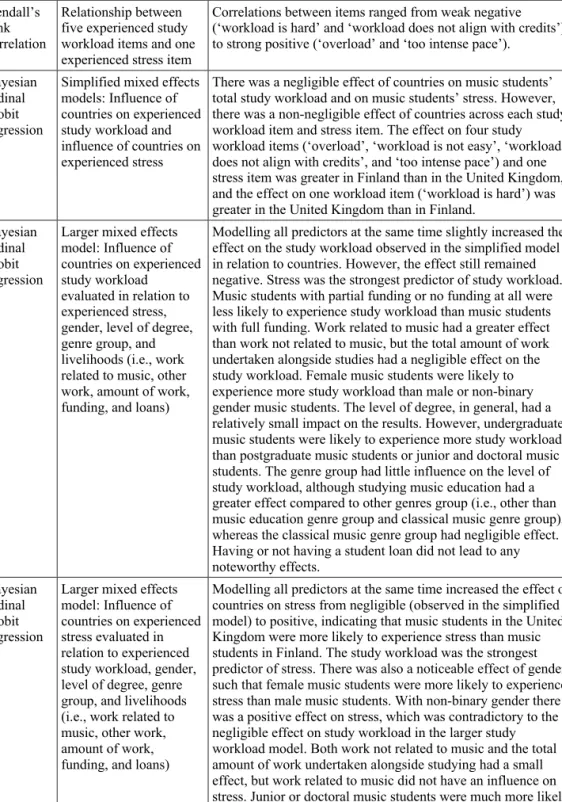
Article IV: Tools for teachers to support music students in managing and coping with their workload in higher education
To adjust course requirements to support students' healthy practice methods, teachers can be more aware of the mental and physical burden that exercise in addition to study at the higher education level causes for students. Recommendations for tools for teachers regarding music students' . workload related to teaching and learning environments. It is important for teachers to understand that harsh and overly critical feedback affects students' mental health.
In addition, it is important that students' anonymity is fully protected in feedback systems so that they can provide honest feedback.
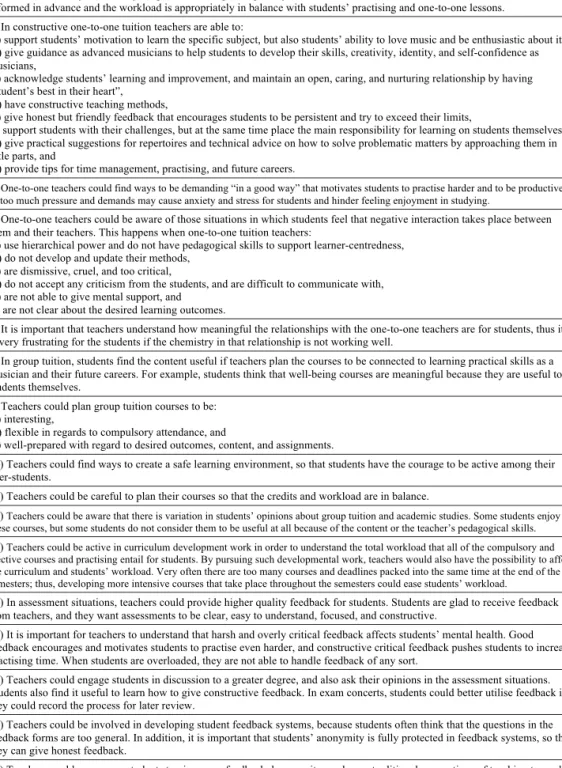
Evaluation of the Workload, Stress, and Coping questionnaire Exploratory Factor Analysis (Appendix 9) was carried out to explore the
Cronbach's Alpha values for the scales in the WSC questionnaire and for the scales in the new factor structure. Respondents' feedback was coded and grouped into seven categories to evaluate the general structure of the questionnaire (Table 15). This chapter expands on the results and findings presented in the previous chapter – consisting of the four articles and the evaluation of the WSC.
The chapter has four parts that follow four research sub-questions that guide this dissertation to answer the overarching research question: What are music students' experiences of workload, stress and coping in higher education.
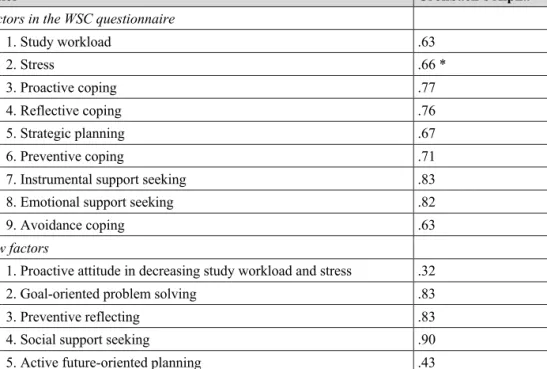
Music students’ experienced workload in higher education
Music students’ experiences in Finland and the United Kingdom The second research sub-question in this dissertation was: How do music
However, the results provided useful insight into music students' lived experiences of dealing with workload and stress in these two countries. The results of Article II indicated that music students' perceived study load is a statistically significant predictor of perceived stress. In Article III, the findings increased the understanding of the predictors of music students' perceived study workload and their link to livelihoods (including socio-demographic characteristics, work during studies, funding and loans) and stress in higher education.
Degree level and genre group have only a small effect on the experienced study load of music students.
Practical implications
Understanding music students' experienced workload may enable teachers to improve their students' learning experiences more generally. The fourth recommendation suggests that higher music education should invest resources in providing more longitudinal, cross-cultural and interventional. research examining music students' discipline-specific experiences of workload and stress. It is essential to provide evidence on the different aspects of music students' experienced workload and stress, because these experiences differ from the workloads in other fields.
According to Hallam and Papageorgi (2016), it is also essential to nurture the love and enjoyment of music students alongside their studies.
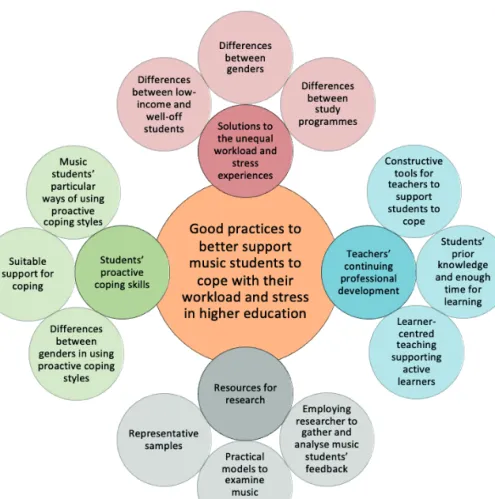
Limitations
Moreover, a practical model can help music institutions to collect and analyze this particular set of qualitative data on the workload experiences of music students during their studies (Jääskeläinen, 2022b). Additionally, the third methodological implication for higher music education is that institutions should consider hiring a researcher who can conduct longitudinal, cross-institutional, international, cross-cultural, and interventional research on music student workload, stress, and coping. . It would then be possible to include student comments as accurate results and findings to contribute to the developmental work in the institutions (Jääskeläinen, 2022b).
In addition, it might be useful to collect additional data on teachers' and administrative staff's experiences with student workloads to triangulate students' self-reported experiences.
Conclusions
It has been beneficial to understand and support specific characteristics of music students' learning (Reid, 2001), in terms of helping them cope with different and specific types of workloads in higher music education. As the Exploratory Factor Analysis (Appendix 9) and participants' feedback in the WSC questionnaire showed, music students' use of proactive coping styles also deserves further attention. The qualitative data in this thesis identified music students' particular ways of dealing with their studies, which were presented in the fifth chapter.
In the systematic literature review (Article I) and empirical data (Articles II-IV) a total of 27 codes of the perceived workload of music students in higher education were identified.
Further research
More research is also needed to examine multicultural factors influencing music students' experiences of higher education workload and stress. This thesis can provide a practical model to address the experiences of music students by using a transcendental phenomenological approach. Indeed, the feedback from music students in the WSC questionnaire indicated that the experiences of music students in higher music education institutions should be carefully examined in relation to the workload.
Fit to perform: An investigation into higher education music students' perceptions, attitudes and behaviors towards health.
Article I
Included: Studies examining the quality or quantity and quality of student workloads in higher education. Included: Studies that examined the quality or quantity and quality of music students' experiences of studying in higher education. This topic also includes the music-specific workload and, in particular, the ability of music students to cope with it.
This systematic review explored the published literature reporting research on student workload in higher education. Institutions should also use evidence-based approaches to develop music students' self-confidence (Miller & Chesky, 2004). Supplementary material for the article "Experienced workload of music students in higher education: A systematic review and recommendations for good practice".
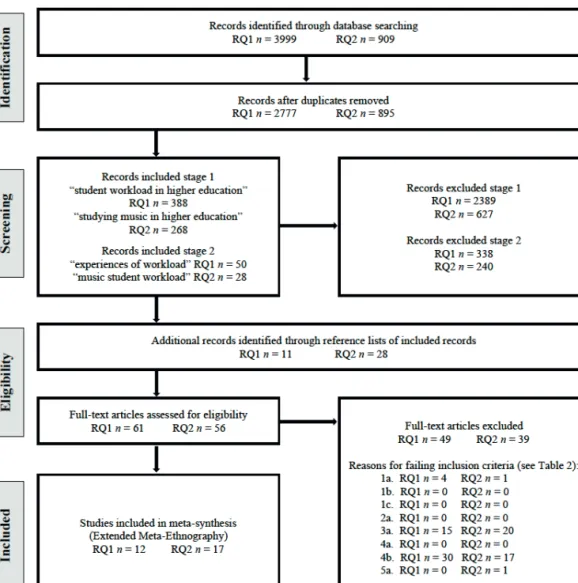
Article II
The lived experiences of music students were analyzed to find the determinants of their workload, stress and coping. According to Deasy et al. 2014), “significant levels of psychological distress have been reported in higher education students globally. In our previous research (Jääskeläinen et al., forthcoming), we conducted a systematic review to compile previous research on music students' experiences of workload in higher education and recommendations for interventions.
A total of 155 music students (108 in Finland and 47 in the United Kingdom) completed the questionnaire in five different institutions (including a total of 5,900 music students).
